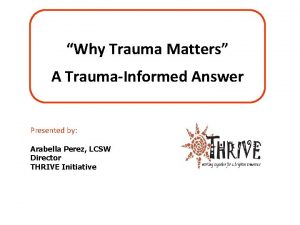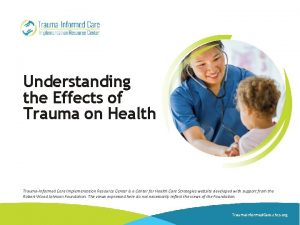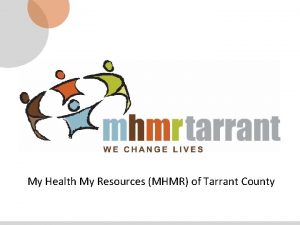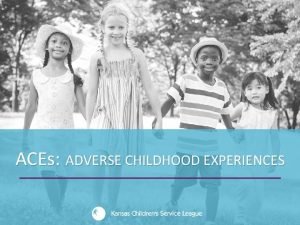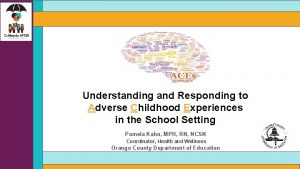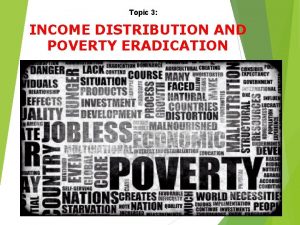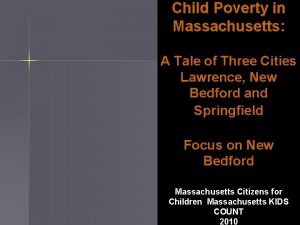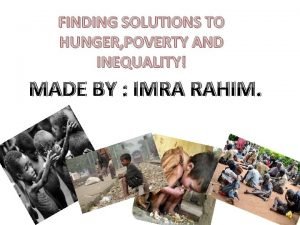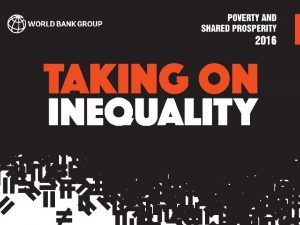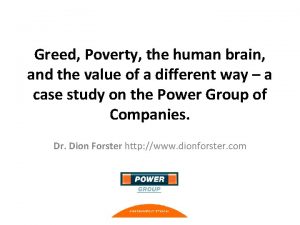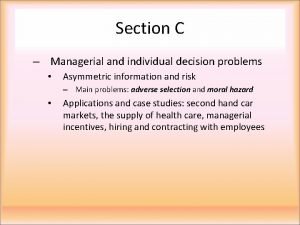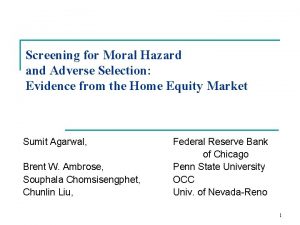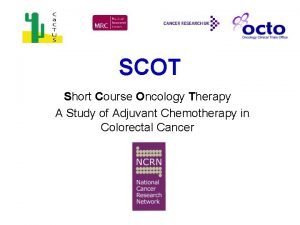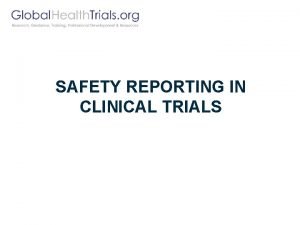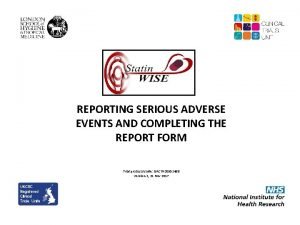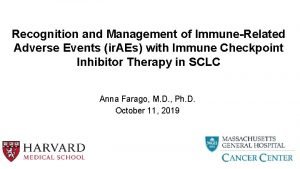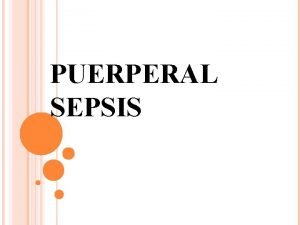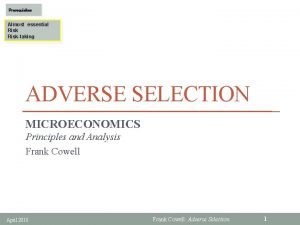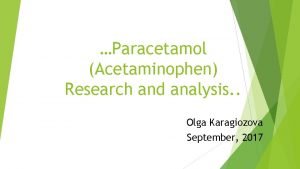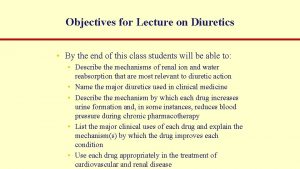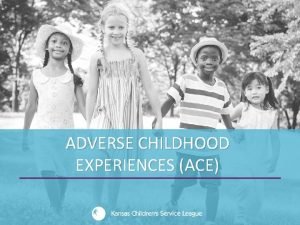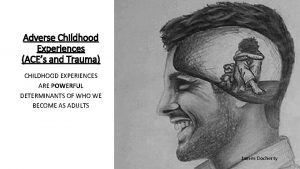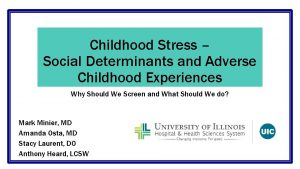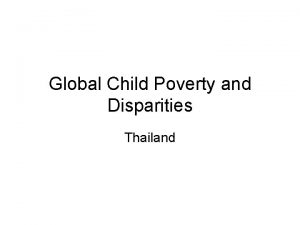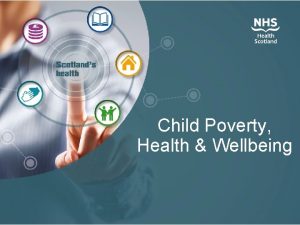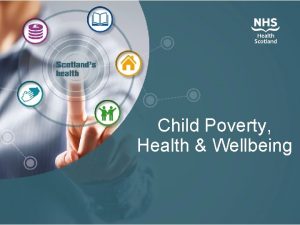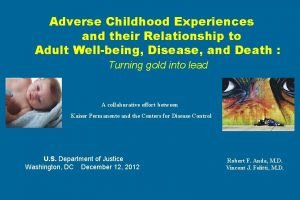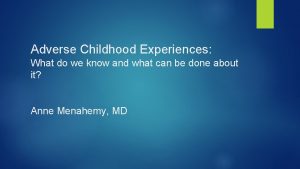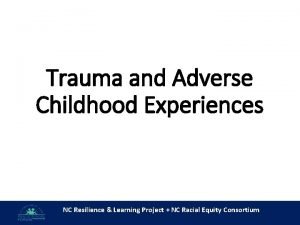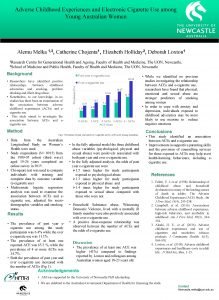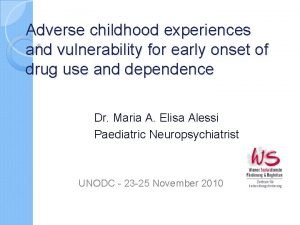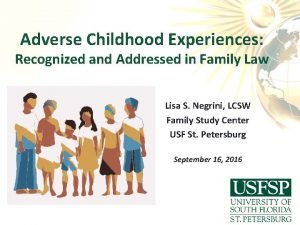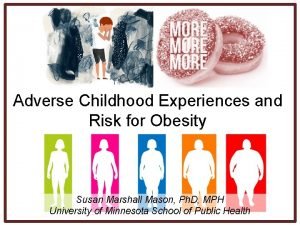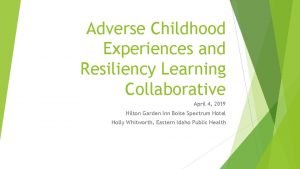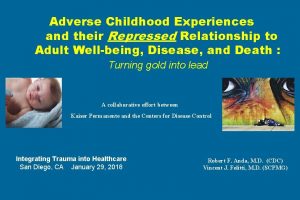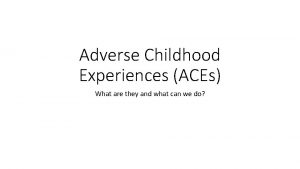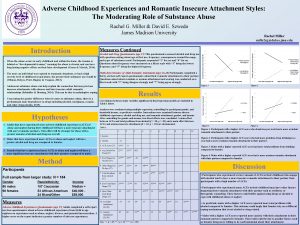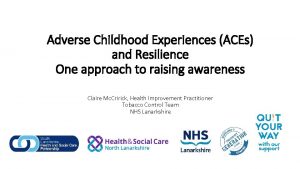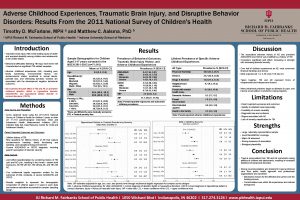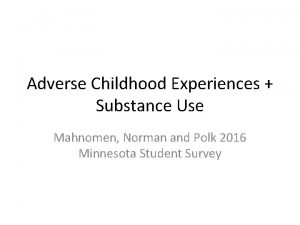Child poverty adverse childhood experiences and A Trusted
































- Slides: 32

Child poverty, adverse childhood experiences, and ‘A Trusted Adult’. Gillian Amos, Senior Health Promotion Specialist NHS Lothian

Inequalities: Inequalities are the unfair and avoidable differences in people’s health (learning & economic circumstance) across social groups and between different population groups.

• People in more equal societies live longer, have better mental health and have better chances of a good education regardless of their background. • International research shows that where the income gap is narrower: – community life is stronger – children do better at school – children are less likely to become teenage parents – people trust each other more – there is less violence and – rates of imprisonment are lower

Inequalities account for a significant element of the increasing demands on our public services because of a persisting cycle of deprivation: children and young people brought up in deprived circumstances are more likely to be deprived in later life, which affects the life chances of their children.


The Chief Medical Officer’s Ten Tips for Better Health 1 Don’t smoke. If you can, stop. If you can’t, cut down 2 Follow a balanced diet with plenty of fruit and vegetables 3 Keep physically active 4 Manage stress by, for example, talking things through and making time to relax 5 If you drink alcohol, do so in moderation 6 Cover up in the sun, and protect children from sunburn 7 Practise safer sex 8 Take up cancer screening opportunities 9 Be safe on the roads: follow the Highway Code 10 Learn the First Aid ABC – airways, breathing and circulation Source: Do. H (1999) Saving Lives: Our Healthier Nation. London: The Stationery Office

Townsend Centre's alternative tips for better health • • • Don’t be poor. If you are poor, try not to be poor for too long Don’t live in a deprived area. If you do, move Don’t be disabled or have a disabled child Don’t work in a stressful low-paid manual job Don’t live in damp, low quality housing or be homeless Be able to afford to pay for social activities and annual holidays Don’t be a lone parent Claim all benefits to which you are entitled Be able to afford to own a car Use education as an opportunity to improve your socio-economic position Source: Townsend Centre for International Poverty Research, University of Bristol

“Having insufficient money to lead a healthy life is a highly significant cause of health inequalities. ” Professor Sir Michael Marmot Review, England 2010. http: //www. instituteofhealthequity. org/projects/fair-society-healthy-lives-themarmot-review

Relationship between child poverty, health & inequalities • Children’s early life experiences and the social circumstances in which they live strongly influence their outcomes in later life. • Inequalities begin before birth, can adversely impact health throughout adult life, and can persist across generations. • There is a link between socio-economic disadvantage during the early years and health inequalities. • The opportunity to reduce the impact of these inequalities is likely to decline as children age. • Income matters for child health & wellbeing

EIS members survey 2016/17 • Impact on physical and mental health and wellbeing of pupils • pale skin, thin, stress & anxiety, no hot water or heating, no money for snacks/don’t bring a snack, inappropriate clothing for winter, homelessness, hungry, uniforms are worn out • Attendance affected • Social exclusion from extra-curricular activities • Impact on concentration and ability to learn

Themes • Food insecurity • Financial stress and worry • Homelessness / poor housing • Poverty exacerbating poor health ‘Poverty makes children sick’

Educational attainment and inequality • Differences in educational attainment are both a driver and a consequence of poverty • Individuals with higher qualification levels and skills are much more likely to be in employment, and have better employment prospects and higher earnings. • This reduces the risk of poverty for more highly qualified individuals and their children • Evidence that increases in parental income levels directly leads to increases in educational attainment of children living in poverty, and contributes to a substantial narrowing of the attainment gap • Income matters to educational outcomes

Educational inequality • In general, children from poorer families have poorer educational outcomes compared to those from more affluent families • Pre-school children from low income families were about 13 months behind in vocabulary skills and 10 months behind in problem solving skills compared to their affluent peers • Early cognitive development is linked with educational attainment, which, in turn, influences longer-term employment prospects

Mental Wellbeing. . . the 6 box model A Trusted Adult Responding to Distress Whole School Approach / School Connectedness Peer Help and Social Media Guiding Thru the Service Maze Resilience Development in Communities Source: NHS GGC

A Trusted Adult. . The concept of ‘A Trusted Adult’ is to • emphasise the importance of a dependable adult who can support and protect the mental wellbeing of a child and/or a young person. • My World Survey - national study of youth mental health in Ireland. Launched in May 2012 by Headstrong, in collaboration with the University College Dublin (UCD) School of Psychology, it revealed a number of findings about the real mental health needs of our young people.

My World Survey snapshot of results • 1 in 3 young people have experienced mental health problems • 1 in 5 have engaged in self harm • 7 per cent of young adults had reported a suicide attempt • Suicidal thoughts, attempts, and rates of selfharm were higher amongst those who did not discuss their distress with others, the survey found

“What is A Trusted Adult? ” • It’s that person you can talk to when there’s something on your mind; someone you can rely on, and trust to help you out in times of difficulty. • The presence of One Good Adult has been found to be a key indicator of how well a young person copes with their struggles. • Although it’s important for young people to have One Good Adult, it is equally important to be that One Good Adult.

How to be that Trusted Adult Do’s and Don’ts

Skills Required • • • Good Listener Compassionate No Jumping to Conclusions Open Minded Don’t Judge

Supports for One Good Adult • Access to training: – Growing Confidence Training – Scottish Mental Health First Aid Training • Access to Resources: – Resilience Toolkit – Bereavement Toolkit • Digital support – ‘Aye Mind’

Adverse Childhood Experiences “intra-familial events or conditions causing chronic stress responses in the child’s immediate environment. These include notions of maltreatment and deviation from societal norms” (Kelly-Irving et al. , 2013).

What harm does being exposed to ACEs cause? Associations between ACEs and health: – Injury and death in childhood – Premature mortality and suicide – Disease and Illness – Mental illness Potential pathways from ACEs to poor health outcomes: – Health-harming behaviours – Social determinants of health – Neurobiological and genetic pathways

What is the economic impact of ACEs?

Are some people more likely to be affected by ACEs than others? - ACEs are linked to inequalities, although evidence suggests there are other factors that influence susceptibility and resilience; - Children who have at least one stable, committed relationship with a supportive caregiver tend to be more resilient, being able to transform ‘toxic stress’ into ‘tolerable stress’.

It’s all about relationships. . . Children who end up doing well despite adversity have usually had at least one stable committed relationship with a supportive parent, caregiver or other adult. This buffers them from development disruption and builds skills such as the ability to plan, monitor and regulate behaviour and adapt to changing circumstances. National Scientific Council on the Developing Child.

The importance of relationships. . . ‘…the quality of the relationships between children and the adults in their lives, along with children’s levels of emotional wellbeing, will largely determine the outcomes children realise. ’ Children’s Parliament, ‘It’s all about relationships’

40% of our spending is currently accounted for by interventions that could have been avoided by prioritising a preventative approach. COMMISSION ON THE FUTURE DELIVERY OF PUBLIC SERVICES

Full Cluster Feedback – Areas for Improvement • Staff training (on mental health awareness and managing conversations) • Consistency of positive behaviour management across the cluster • Parental support and engagement • Improving the ethos • Knowing school staff roles • Structure day in a way that enables teachers to be that one good adult (e. g. manage time constraints) • Financially friendly school day • System for improving communication between primary and secondary, school and health, school and parents, school and partner agencies, school and wider communi

St Margaret's Cluster – Learning to love loving to learn – Trusted Adult Aim To increase X no of children who report as green on the wellbeing indicators by x (data available January) Primary Driver Mental Health & Wellbeing Secondary Driver Positive confident staff who have good conversations with CYP Staff mental health awareness Parental Awareness on mental health & Wellbeing Pupil mental health awareness Financially friendly school day Poverty Access to opportunities Parental Engagement & Involvement SMHFA Training Growing Confidence Info to parents via app/websites possibly group work Financial advice in schools Basic needs are met Building a positive ethos in the school Inclusion Test ideas Supporting attendance Resilience Package Daily Check in Positive staff – pupil relationships Paul Dix Behaviour Challenge Family learning and involvement Postive Parenting Sleep Scotland Training

Key Learning Points • Full cluster on board to develop driver diagram – staff involved in the process • Improvement methodology useful tool to focus the work and divide up the tasks – very practical way of putting theory into practice • Partnership working • Brings all the policy agendas together (raising Attainment for All, CYPIC, Inequaliites. • Learner focused – brings family/community/school together.

Challenges • Capacity for developing the test ideas and carrying them out, releasing staff for training • Time - one hour per month dedicated to cluster meeting to discuss progress • Other clusters now interested – challenge is how we spread the learning – good or bad • How do we engage 3 rd sector and CLD workforce

Group discussion – What work is currently going on within the CLD workforce that supports mental health and wellbeing? – How can we raise awareness about the importance of a trusted adult and help people recognise their role? – How do we develop the capacity within the workforce to be a trusted adult?
 Adverse childhood experiences study
Adverse childhood experiences study Adverse childhood experiences study
Adverse childhood experiences study Adverse childhood experiences study
Adverse childhood experiences study Adverse childhood experiences study
Adverse childhood experiences study Slidetodoc.com
Slidetodoc.com Distinguish between absolute and relative poverty
Distinguish between absolute and relative poverty Proximodistal development
Proximodistal development Child poverty in massachusetts
Child poverty in massachusetts 승자트리
승자트리 Relative and absolute poverty
Relative and absolute poverty Poverty and juvenile delinquency
Poverty and juvenile delinquency Esperanza’s house symbolizes poverty and
Esperanza’s house symbolizes poverty and St john chrysostom on wealth and poverty pdf
St john chrysostom on wealth and poverty pdf Poverty and hunger solutions
Poverty and hunger solutions Symbolic interactionist perspective on poverty
Symbolic interactionist perspective on poverty Ministry of housing and urban poverty alleviation
Ministry of housing and urban poverty alleviation Inequality and poverty
Inequality and poverty Greed and poverty
Greed and poverty Adverse reaction definition
Adverse reaction definition Sentinel event in hospital in hindi
Sentinel event in hospital in hindi Adverse selection
Adverse selection Adverse selection
Adverse selection Adverse reaction definition
Adverse reaction definition Adverse reaction definition
Adverse reaction definition Adverse events in hospital
Adverse events in hospital Adverse events in hospital
Adverse events in hospital Puerperal sepsis
Puerperal sepsis What is adverse selection
What is adverse selection Acetaminophen mechanism
Acetaminophen mechanism Loop diuretics adverse effects
Loop diuretics adverse effects Analgesic mechanism
Analgesic mechanism Dpp4 inhibitor adverse effects
Dpp4 inhibitor adverse effects Adverse selection
Adverse selection
